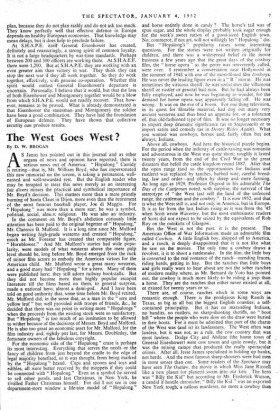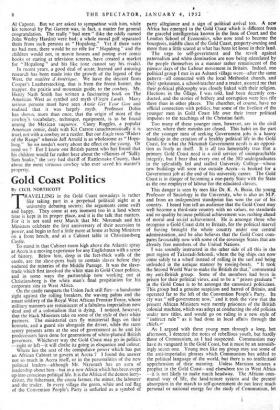The West Goes West By D. W. BROGAN A S Janus
has pointed out in this journal and as other organs of news and opinion have reported, there is serious news out of America. "Hopalong " Cassidy is retiring—that is, Mr. William Boyd, who has impersonated this new immortal on the screen, is taking a permanent, well- earned and well-rewarded rest. But the English reader who may be tempted to treat this news merely as an interesting fait divers misses the practical and symbolical importance of Mr. Boyd's decision. This matters more than a mere priestly burning of Santa Claus in Dijon, more even than the retirement of the most famous baseball player, Joe di Maggio. For " Hopalong " was more than a mere star; he was a symbol, political, social, almc.,;. religious. He was also an industry. In the comment on Mr. Boyd's abdiction curiously little attention has been paid to the original begetter of " Hopalong," Mr. Clarence B. Mulford. It is a long time since Mr. Mulford began writing high-grade westerns and created "Hopalong," much as Mr. Forester has created that comparable figure, " Homblower." And Mr. Mulford's stories had wide popu- larity, were models of what westerns above the mere pulp level should be, long before Mr. Boyd emerged from the ruck of minor film actors to embody the American virtues for the American child. Mr. Mulford wrote a great many westerns, and a good many had "Hopalong " for a hero. Many of them were published here; they still adorn railway bookstalls. But they did not become more than highly popular escapist literature till the films based on them, to general surprise, made a national hero, almost a demi-god. And I have been told on good authority that, some time before Mr. Boyd retired, Mr. Mulford did, in the sense that, as a man in the " sere and yellow leaf " but well provided with troops of friends, &c., he decided that there was no point in writing more " Hopalongs " when the proceeds from the existing stock were so satisfactory. But " Hopalong " is too much of an institution to be allowed to wither because of the decisions of Messrs. Boyd and-Mulford. He is also too great an economic asset for Mr. Mulford, for the film industry and, rightly put last, for Messrs. Doubleday, the fortunate owners of the fabulous copyright.
For the economic side of the " Hopalong " craze is perhaps its most interesting. Everything that serves the needs or the fancy of children from just beyond the cradle to the edge of legal majority benefited, so it was thought, from being marked by the " Hopalong " brand. Cups and spoons and toys and edibles, all were better received by the moppets if they could be connected with " Hopalong." Even as a symbol he served to sell other goods, and last Christmas, in New York, he rivalled Father Christmas himself. For did I not see in one department-store window a life-size model of " Hopalong " and horse entirely done in candy ? The horse's tail was of spun sugar, and the whole display probably took sugar enough for the week's sweet ration of a good-sized English town. No; commerce, if not art, will not willingly let " Hopalong " die.
But " Hopalong's " popularity raises some interesting questions. For the stories were not written originally for children, and there was a widespread belief in the movie business a few years ago that the great days of the cowboy film, the " horse opera " as the genre was irreverently called, were over. I remember a conversation near Hollywood in the summer of 1948 with one of the most-filmed film Cowboys. He was never the leading figure even in a " B " movie. He was sometimes the virtuous sheriff; he was sometimes the villainous sheriff or rustler or general bad man. But he had always been fully employed, and now he was beginning to wonder, for the demand for horse opera was apparently falling off. He was wrong. It was on the eve of a boom. For one thing television, in its quest for filmable material, had dug out many very ancient westerns and thus bred an appetite for, or a tolerance of, that old-fashioned type of film. It was no longer necessary to import deep dramatic significance (as in Stagecoach) or to import satire and comedy (as in Destry Rides Again). What you wanted was cowboys, horses and, fairly often but not always, Indians.
Above all, cowboys. And here the historical puzzle begins. For the period when the industry of cattle-raising was romantic and adventurous in the West was quite short; roughly it lasted twenty years, from the end of the Civil War to the great disasters that befell the cattle kingdom round 1887. After that the open range (and so the opportunities for Indians and rustlers) was replaced by ranches, barbed wire, careful breed- ing, law and order—and often by sheep and mere farming. As long ago as 1929, Professor Osgood in his admirable The Day of the Cattleman noted, with surprise, the survival of the stereotype of the West (as) still the land of the unfenced range, the cattleman and the cowboy." It is now 1952, and that is what the West still is, and not only in America, but in Europe. It is as far from the last Indian rising as it was from the '45 when Scott wrote Waverley, but the most enthusiastic readers of Scott did not expect to be seized by the equivalents of Rob Roy on the outskirts of Glasgow.
But the West is not the past; it is the present. The American Office of War Information made an 'admirable film called Cowboy. A little English boy, shipped off to America, and a ranch, is deeply disappointed that it is not like what he saw on the movies. The only time a cowboy draws a revolver, it is to shoot a rattlesnake. In the film, the little boy is converted to the real romance of the ranch—mending fences, riding herds, getting in hay. But the ranches that little boys and girls really want to hear about are not the sober ranches of modern reality where, as Mr. Bernard de Voto has pointed out, the cowboy is much more likely to be riding a jeep than a horse. They are the ranches that either never existed at all, or existed for twenty years or so.
There are, of course, ranches which in some ways are romantic enough. There is the prodigious King Ranch in Texas, as big as all but the biggest English counties; a self- contained principality. But it has no marauding Indians, no bandits, no rustlers, no sharp-shooting sheriffs, no " boot hill " where the people who were slow on the draw were buried in their boots. For it must be admitted that part of the charm of the West was (and is) its lawlessness. The West often was lawless, but it was not, as a rule, the cow country that was most lawless. Dodge City and Abilene (the home town of General Eisenhower) were cow towns and quite rowdy, but it was the mining camps that produced the really spectacular crimes. After all, Jesse James specialised in holding up banks, not herds. And the most famous sharp-shooters were bad men in more senses than one. Some readers of the Spectator may have seen The Outlaw, the movie in which Miss Jane Russell like a new planet (or planets) swam into our ken. The hero was " Billy the Kid" but according to Mr. Frederick Watson, a candid if hostile chronicler, " Billy the Kid " was an exported New York tough, a callous murderer, no more a cowboy than Al Capone. But we are asked to sympathise with him, while his removal by Pat Garrett- was, in fact, a matter for general congratulation. The really " bad men " (like the oddly named John Wesley Hardin) were bad; a whole moral gulf separated thefn from such persons as " Hopalong." Yet if there were no bad men, there would be no role for " Hopalong " and the children would not, in movie houses and poring over comic books or staring at television screens, have created a market for " Hopalong " and his like (one cannot say his rivals).
In recent years, a good deal of acute, learned and amusing research has been made into the growth of the legend of the West, the matiere d'Amerique. We have the descent from Cooper's Leatherstocking, that is from the forest hunter, the trapper, the prairie and mountain guide, to the cowboy. Mr. Henry Nash Smith has written a fascinating book on The American West as symbol and myth (Virgin Land). Many serious persons must have seen Annie Get Your Gun and realised that it was largely myth. Professor Dobie has shown, more than once, that the origin of most of the cowboy's vocabulary, technique, equipment, is to be found among the Mexican vaqueros. Casey Ruggles, a popular American comic, deals with Kit Carson (anachronistically it is true), not with a cowboy or a rustler. But our Eagle runs "Riders of the Range" wherein Jeff Arnold is as wholesome as " Hopa- long." So we needn't worry about the effect on the young. Or need we ? For I know one British parent who has found that his children would far rather hear about the villainies of "Sulky Sam Snake," the very bad sheriff of Rattlesnake County, than about the most virtuous cowboy who ever saved his master's property.







































 Previous page
Previous page